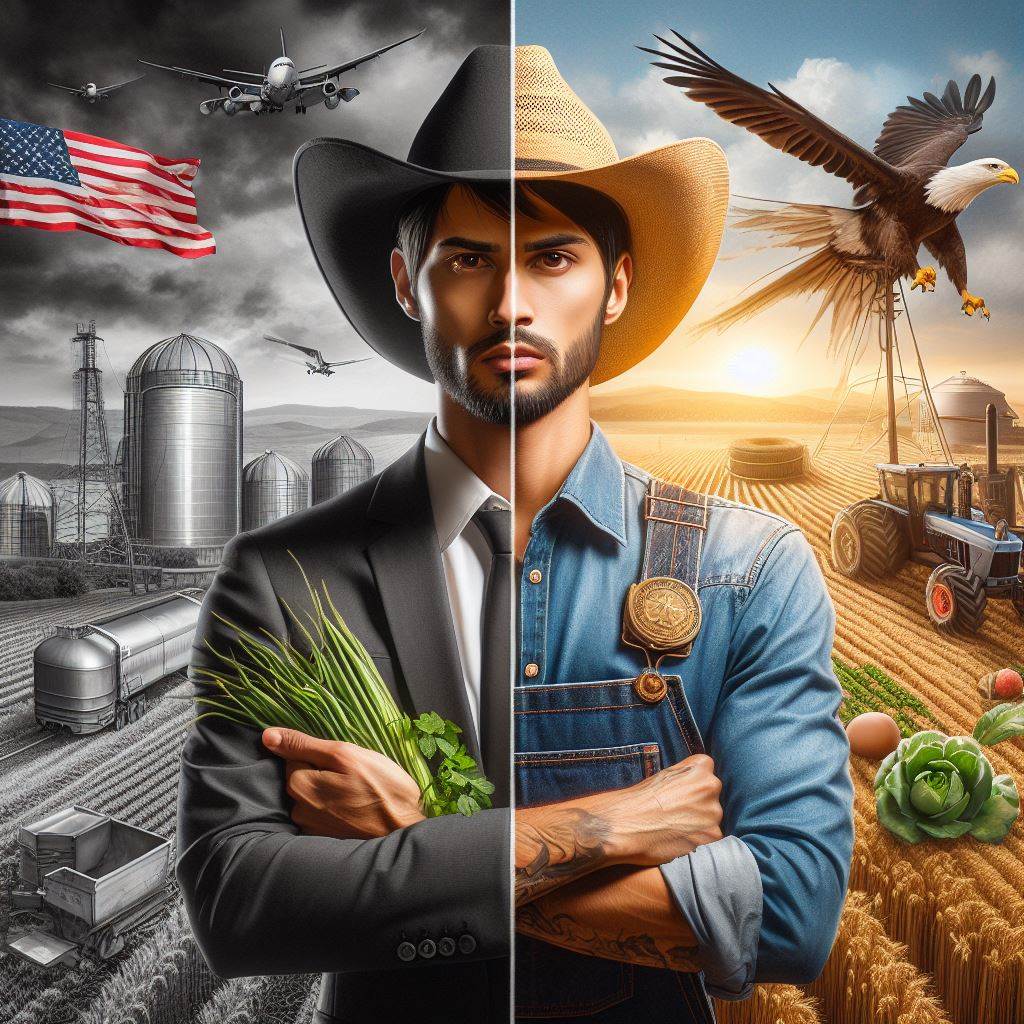Farming Regulations: State vs. Federal
Last Updated on March 2, 2024
Introduction
Importance of farming regulations
Farming regulations play a vital role in ensuring the safety and sustainability of our food supply.
They aim to protect consumers from harmful chemicals, promote ethical farming practices, and prevent environmental degradation.
Difference between state and federal regulations
State and federal farming regulations differ in their scope and level of authority.
State regulations are specific to each state and may vary, while federal regulations apply across the entire country.
The federal government sets the minimum standards, while states can implement stricter rules.
Regardless of the level of government, regulations are necessary to ensure the proper handling of pesticides, the safety of agricultural workers, and the prevention of disease outbreaks.
These regulations also address issues like animal welfare, water quality, and genetically modified organisms.
State Regulations
State agricultural departments are responsible for enforcing and implementing farming regulations within their respective states.
They have the flexibility to address local challenges and set specific standards according to their unique agricultural practices and environmental concerns.
States may have different licensing requirements, inspection procedures, and labeling regulations.
This allows them to cater to the specific needs of their local farmers and consumers.
Federal Regulations
Federal farming regulations provide a baseline for all states to follow.
Agencies like the United States Department of Agriculture (USDA) and the Environmental Protection Agency (EPA) set standards that apply uniformly across the country.
These regulations cover a wide range of areas, from food safety to land conservation.
Federal agencies ensure compliance by conducting inspections, investigations, and providing technical assistance to farmers.
Both state and federal farming regulations are essential for maintaining the integrity of our food supply and protecting public health.
While states have the flexibility to address local challenges, federal regulations set the minimum standards that all farms must meet.
By working together, state and federal authorities can create a robust regulatory framework that ensures the safety and sustainability of our agricultural practices.
Federal Farming Regulations
Overview of federal agencies responsible for regulations
Federal farming regulations play a crucial role in ensuring the safety and sustainability of the agricultural industry.
These regulations are enforced by several federal agencies, each responsible for overseeing specific aspects of farming.
The Food and Drug Administration (FDA) is primarily responsible for regulating food safety.
The FDA’s regulations under the Food Safety Modernization Act (FSMA) mandate preventive measures to reduce foodborne illnesses.
These regulations set standards for the safe growing, harvesting, packing, and holding of produce.
They also require farmers to implement measures to prevent contamination during transportation.
Examples of federal regulations in farming
The Environmental Protection Agency (EPA) also plays a significant role in federal farming regulations.
The EPA’s regulations focus on protecting the environment from potential harm caused by farming practices.
These regulations govern the use of pesticides, herbicides, and fertilizers to minimize their impact on waterways, air quality, and ecosystems.
Farmers must adhere to specific guidelines and obtain appropriate permits for certain activities to ensure compliance with the EPA’s regulations.
The Department of Agriculture (USDA) is another important federal agency involved in farming regulations.
The USDA has a wide range of rules that cover various aspects of farming.
These rules include farm subsidies, crop insurance programs, and livestock management regulations.
The USDA also establishes standards for organic farming and certifies organic products.
Federal farming regulations are essential for maintaining high standards of safety, environmental sustainability, and fair practices in the agricultural industry.
By enforcing these regulations, the federal government aims to protect consumers, preserve natural resources, and support the long-term viability of the farming sector.
However, critics argue that federal regulations can sometimes be burdensome and hinder innovation and economic growth in the agricultural industry.
They argue that excessive regulations make it challenging for small farmers to comply and can lead to increased costs and decreased competitiveness.
Balancing the need for regulation with the desire for a thriving agricultural sector is an ongoing challenge.
Therefore, federal farming regulations are necessary to ensure the safety, environmental sustainability, and fair practices in the agricultural industry.
The FDA, EPA, and USDA are federal agencies responsible for enforcing these regulations.
Examples of federal regulations include the FSMA, EPA regulations, and USDA rules.
While these regulations are essential, finding the right balance between regulation and fostering a thriving agricultural sector remains a challenge.
Read: US Farmers: Understanding Organic Benefits
State Farming Regulations
Role of State Governments in Farming Regulations
State governments play a critical role in establishing and enforcing regulations related to farming.
They have the power to develop laws and policies that promote agricultural practices that align with their specific needs and priorities.
This allows states to have more control and flexibility in regulating farming activities within their jurisdictions.
Examples of State Regulations in Farming
Water Usage and Irrigation Laws
State governments enact regulations to govern the use of water resources for farming purposes.
These laws may include restrictions on water diversion, groundwater extraction, and water conservation practices.
States tailor their regulations to reflect the availability, quality, and sustainability of water resources in their regions.
For instance, arid states like California have stringent water management regulations due to water scarcity concerns.
Pesticide and Herbicide Application Restrictions
States establish regulations to control the use of pesticides and herbicides in farming.
These regulations ensure that the application of such chemicals follows safety guidelines and limits potential harm to the environment and public health.
States may require farmers to obtain licenses or permits to use specific pesticides and herbicides.
They also set criteria for the storage, handling, and disposal of these chemicals to prevent pollution and safeguard human and animal health.
Livestock Health and Welfare Regulations
State governments implement policies to safeguard the health and welfare of livestock in farming operations.
These regulations cover various aspects including animal housing, transportation, nutrition, and veterinary care.
States often set standards for the prevention and control of diseases, as well as the humane treatment of animals.
They may conduct inspections and require farmers to maintain records to ensure compliance with these regulations.
State farming regulations serve as a complement to federal regulations, allowing states to address specific farming challenges and issues that are unique to their geographical and economic contexts.
They recognize the diversity in agricultural practices and enable states to prioritize the well-being of their local farming communities, natural resources, and consumers.
However, inconsistencies among state regulations can create challenges for farmers who operate across state lines.
Therefore, coordination and cooperation between state and federal authorities are important to ensure a harmonized and fair regulatory framework.
Overall, state farming regulations play a crucial role in promoting sustainable and responsible farming practices while addressing the specific needs of local agricultural industries and environments.
Read: Latest USDA Organic Regs: What’s New?

Comparison between State and Federal Regulations
Variations in rules and standards
States may have different regulations and standards for farming compared to the federal government.
These variations can create confusion and difficulties for farmers who operate across multiple states.
Federal regulations aim to provide a consistent framework, while states can tailor their rules to specific local needs.
Some argue that state regulations allow for better customization and responsiveness to regional agricultural challenges.
However, these variations can also result in inconsistent practices and disparities among different regions.
States must balance their desire for flexibility with the need to maintain fair and equitable standards.
Impact on farmers and agricultural businesses
Compliance costs
Complying with different state and federal regulations can be costly for farmers and agricultural businesses.
They must spend resources to understand and adhere to various rules, which can increase operational expenses.
This financial burden can disproportionately affect small farms and hinder their ability to compete in the market.
Administrative burden
Farmers often face administrative challenges due to the complexity of complying with multiple sets of regulations.
They may need to hire additional staff or consultants to navigate the regulatory landscape.
This administrative burden takes time and focus away from actual farming activities, negatively impacting productivity.
Access to markets
Differences in state and federal regulations may affect farmers’ access to markets beyond their own state.
Selling products across state lines can be subject to additional compliance requirements and certification processes.
For small farmers, these barriers may limit their ability to expand their customer base and compete in larger markets.
In essence, farming regulations can vary between states and the federal government, leading to a range of impacts on farmers and agricultural businesses.
While state regulations allow for customization and responsiveness, they can also create inconsistencies and disparities.
Compliance costs, administrative burdens, and limited access to markets are some of the challenges faced by farmers operating under different regulatory systems.
Finding a balance between state and federal regulations is necessary to ensure fair practices, promote industry growth, and support sustainable agriculture across the country.
Read: Navigating Organic Certification in the US
See Related Content: Federal Water Usage Laws for US Farms in 2024
Pros and Cons of State vs. Federal Regulations
Advantages of federal regulations
Federal regulations provide national consistency in farming practices.
This means that farmers across all states follow the same set of rules, ensuring uniformity and streamlining operations.
National consistency eliminates confusion and prevents farmers from facing different requirements when operating in different states.
Additionally, the federal government has access to greater expertise and resources to effectively regulate the farming industry.
They can conduct more comprehensive research, implement stricter guidelines, and enforce regulations more efficiently.
This ensures that farming practices adhere to national standards and protect the environment, public health, and food safety on a broader scale.
Advantages of state regulations
On the other hand, state regulations offer flexibility and customization.
Different regions may have distinct farming needs and challenges.
State regulations allow local authorities to tailor rules according to these specific requirements.
This flexibility enables them to address unique circumstances and implement regulations that are most effective for their particular area.
Another advantage of state regulations is the local knowledge and understanding of farming practices and environmental conditions.
Each state has a better grasp of the intricacies and nuances of their own agricultural industry.
They can work closely with local farmers to develop regulations that consider these factors, resulting in better outcomes and more sustainable farming practices.
It is important to note that while federal regulations provide consistency, they may not always be able to account for every regional variation.
State regulations fill this void and ensure that farming practices are better attuned to the specific needs and conditions of each state.
In fact, both federal and state regulations have their own advantages when it comes to farming.
Federal regulations provide national consistency and access to greater expertise and resources.
On the other hand, state regulations offer flexibility, customization, and a better understanding of local conditions.
A balanced approach that incorporates the strengths of both federal and state regulations would be most beneficial in ensuring effective and sustainable farming practices across the country.
Read: US Farm Policy: 2024’s Big Shifts
Recent Developments and Challenges
Changes in federal regulations and policies
- The farming industry has experienced significant changes in federal regulations and policies.
- These changes aim to streamline processes, enhance productivity, and promote sustainable practices.
- Federal agencies have revised regulations related to crop production, livestock management, and environmental conservation.
- The updates in federal regulations have focused on improving food safety standards and reducing the environmental impact of farming practices.
- Some of the changes include stricter guidelines for the use of pesticides, improved labeling requirements, and stricter monitoring of animal welfare.
Legal and political challenges regarding jurisdiction
- One of the major challenges in farming regulations is the conflict between state and federal jurisdiction.
- States have the authority to establish their own regulations, leading to inconsistencies and complications in interstate commerce.
- States often differ in their approach to issues such as labeling requirements, land use restrictions, and animal welfare standards.
- The lack of uniformity among state regulations creates difficulties for farmers operating in multiple states.
- Legal battles have arisen when state regulations conflict with federal guidelines, resulting in uncertainty and confusion among farmers.
Potential harmonization efforts between state and federal regulations
- Recognizing the challenges posed by divergent regulations, there have been growing efforts towards harmonization.
- By working together, states and federal agencies can ensure that farming regulations are consistent and effective.
- Collaboration between state and federal authorities can help establish common standards while respecting local variations.
- Harmonization efforts aim to reduce regulatory burdens for farmers, promoting efficiency and fair competition.
- Through regular communication and coordination, both levels of government can address the concerns and needs of the farming community.
In short, recent developments in farming regulations have prompted changes in federal policies to enhance food safety and environmental sustainability.
However, legal and political challenges regarding jurisdiction have hindered the establishment of consistent regulations across states.
To overcome these challenges, there is a need for harmonization efforts between state and federal authorities.
Collaboration and coordination can ensure that farming regulations are effective, efficient, and fair for farmers across the nation.
Conclusion
Recap of key points
Throughout this blog section, we have discussed the differences between state and federal farming regulations.
We explored their respective roles, the challenges faced, and the need for cooperation between them.
Call-to-action for farmers and regulators
It is crucial for farmers and regulators to collaborate and establish effective and balanced regulations.
This collaboration will ensure the economic viability of farming operations, protect the environment, and ensure the safety of consumers.
By working together, farmers and regulators can strike a harmonious balance that supports sustainable farming practices.
The recognition of each party’s role and expertise is vital in crafting regulations that address the unique needs of different regions while upholding national standards.
Moreover, open dialogue and continuous communication can facilitate the exchange of knowledge, experiences, and best practices.
Farmers must engage with regulators to voice their concerns and provide valuable insights that can shape future regulations.
Regulators, on the other hand, should actively seek input from farmers and industry experts to better understand the practical implications of regulations.
This collaborative approach will lead to regulations that are practical, enforceable, and capable of promoting a thriving agricultural sector.
Successful farming regulations require a well-coordinated effort between state and federal authorities.
Both parties have a responsibility to ensure the prosperity of agricultural endeavors while safeguarding public health, environmental sustainability, and animal welfare.
By working together, farmers and regulators can establish a regulatory framework that enhances the future of farming.


